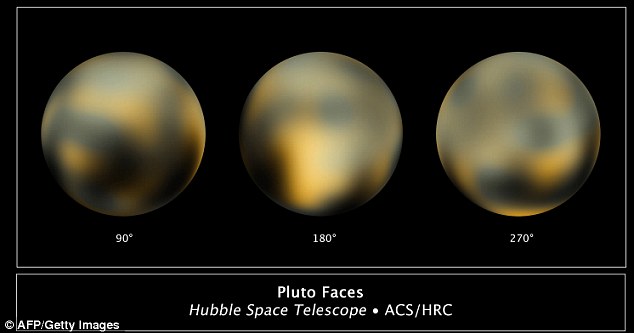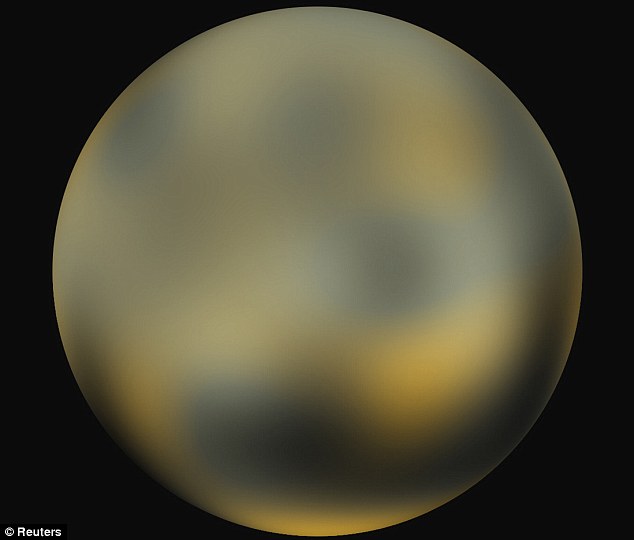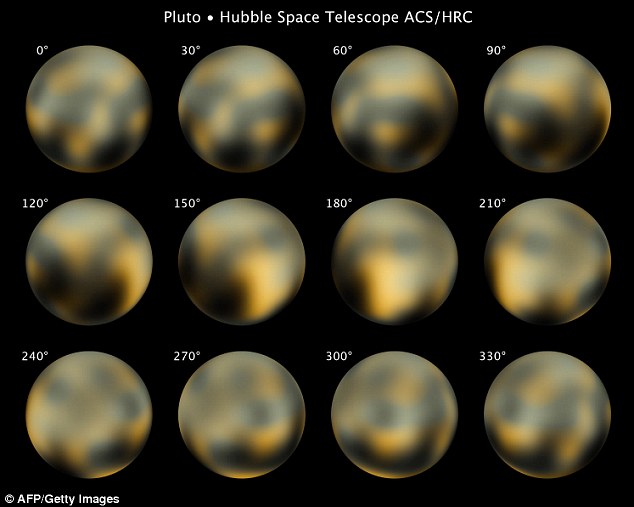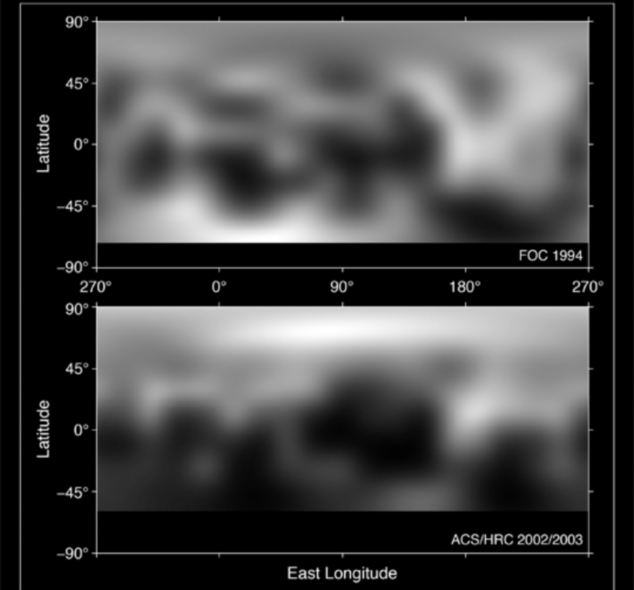
The Hubble Telescope captured the images, which are the most detailed and dramatic ever taken of the distant dwarf planet.
They revealed that the cosmic body, demoted from full planet status in 2006, is significantly redder than it has been for the past several decades.
The photos show a mottled world with a yellow-orange hut, but astronomers say it is 20 per cent more red than it used to be. At the same time its illuminated northern hemisphere is getting brighter, while the southern hemisphere has darkened.
These changes are most likely consequences of surface ice melting on the sunlit pole and then refreezing on the other pole, as the dwarf planet heads into the next phase of its 248-year-long seasonal cycle.
The Hubble pictures underscore that Pluto is not simply a ball of ice and rock but a dynamic world that undergoes dramatic atmospheric changes.
These are driven by seasonal changes that are as much propelled by the planet's 248-year elliptical orbit as its axial tilt, unlike Earth where the tilt alone drives seasons.
It suggests that natural cycles alone can cause unexpected and dramatic climate changes on planets. Some scientists argue global warming on Earth is more likely to have been caused by a regular 1,500-year-cycle of warming and cooling than rising carbon dioxide levels.
All planets experience climate change. Nasa scientists recorded Mars warming by 0.5C since the 1970s, which is similar to the warming experienced on Earth over the same period. In the Red Planet's case, strong winds are thought to have stirred up giant dust storms, trapping heat and raising Mars' temperature.

Marc Buie, of the Southwest Research Institute, said: 'It's a little bit of a surprise to see these changes happening so big and so fast. This is unprecedented.'
Between 1954 and 2000, Pluto did not change in colour when it was photographed from Earth, he added. After that, the red levels increased by up to 30 per cent, and stabilised from about 2000 to 2002.
Mr Buie said he can explain the redness, but not why it changed so dramatically and so recently.
The colour is the result of ultraviolet radiation from the distant Sun breaking up the methane on Pluto's surface and leaving a dark and red carbon-rich residue behind.
The Hubble photos were taken in 2002 and analysis suggests the changes took place between 2000 and 2002.
Mr Buie held off for years on announcing what he had found because the speed in which Pluto changed was such a mystery and he was worried that he might be wrong.
However, since Pluto's moon Charon had not changed colour in the same telescope images, he decided the Pluto findings were not an instrument mistake.
His analysis also found that nitrogen ice was shifting in size and density in surprising ways.
It is incredibly cold on Pluto and the bright spots are the coldest at around -230C.
Astronomers are still arguing about the temperatures of the warmer dark spots, which Mr Buie believes may be 17C warmer than lighter areas.
Part of the difficulty in explaining what is happening on the surface of Pluto is that it takes the dwarf planet 248 years to circle the Sun, so astronomers don't know what the conditions are like when it is at its farthest from our local star.

Retired Nasa astronomer Stephen Maran, co-author of a book on Pluto, said: 'Pluto is interesting and poorly understood, whether it qualifies as a planet or not.'
The Hubble images will remain the sharpest view of Pluto until Nasa's New Horizons probe is within six months of its flyby during 2015.
They are invaluable for picking the planet's most interesting hemisphere for imaging by the probe, as it will pass by Pluto so quickly only one can be photographed in detail.
Particularly noticeable in the Hubble images is a bright spot that has been independently noted to be
unusually rich in carbon monoxide frost. It is a prime target for New Horizons.
'Everybody is puzzled by this feature,' Buie said.
'New Horizons will get an excellent look at the boundary between this bright feature and a nearby region covered in pitch-black surface material.'




... there's something bright hanging over Pluto?
I know.
I'm oversimplifying.
Think:
BiiiiiiG ReD...